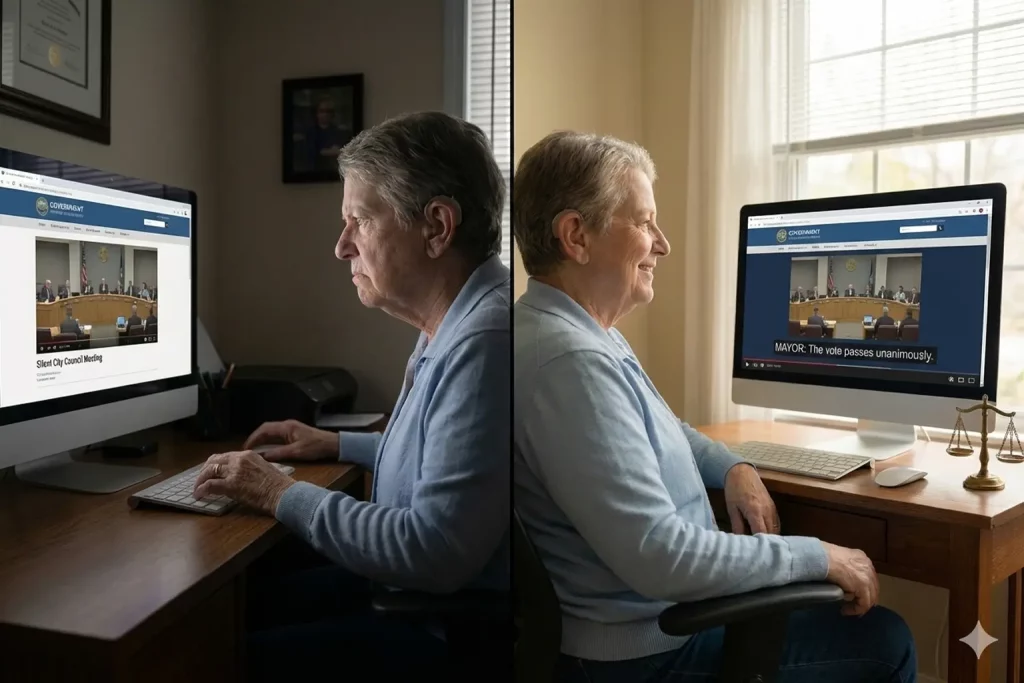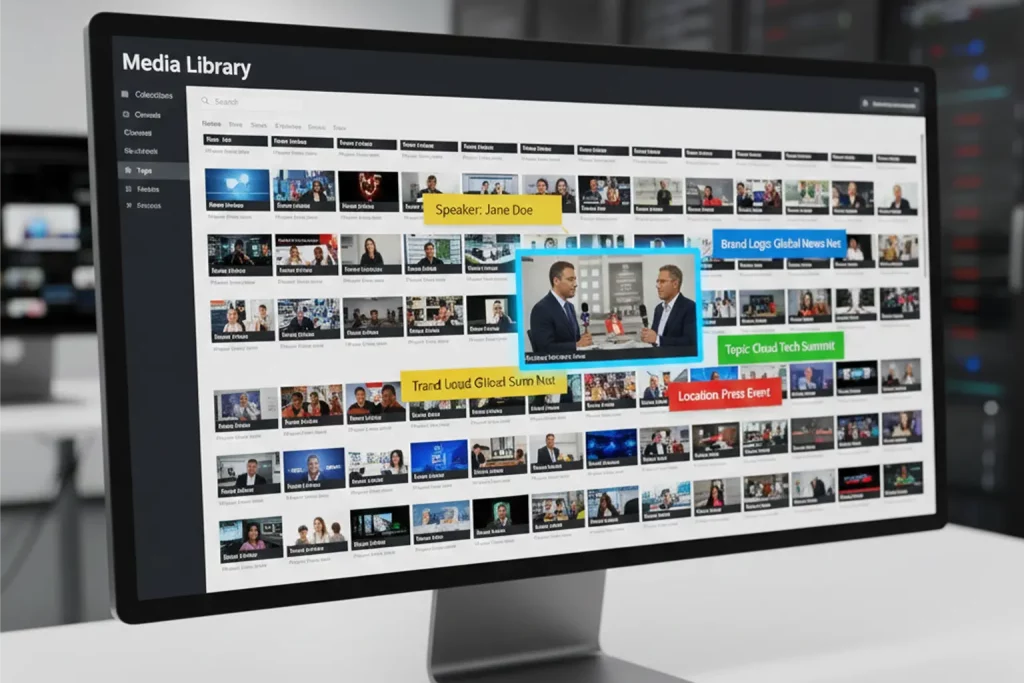Video content is everywhere—from blockbuster films to bite-sized social media clips. However, not everyone experiences videos in the same way. Whether watching a foreign film, learning a new language, or catching a video in a noisy room, subtitles and closed captions are crucial in keeping content accessible and engaging.
While the two terms are often used interchangeably, they serve different purposes. Understanding the difference can help you connect with a wider audience and improve viewer experience.
What Are Subtitles?
Subtitles are text overlays that display dialogue and key speech elements on a screen. They translate spoken words into written form, ensuring clarity for viewers who may not understand the language or miss spoken words.
The Purpose of Subtitles
The main goal of subtitles is to aid comprehension and break language barriers. You often see subtitles in:
- Foreign Films: Movies or shows produced in other languages for a global audience.
- Streaming Platforms: Services like Netflix and Hulu offer multi-language subtitles to expand their reach.
- Educational Content: Subtitles clarify complex terminologies for students.
Where Are Subtitles Commonly Seen?
- International films and TV shows
- Online video platforms like YouTube and Vimeo
- Training or tutorial videos
- Social media platforms to keep content consumable in silent mode
In essence, subtitles ensure that anyone, regardless of their native language, can enjoy and understand video content.
What Is Closed Captioning?
Closed captioning (CC) displays dialogue, sound effects, and other audio cues as text on a screen. Unlike subtitles, closed captions are created to assist the deaf and hard-of-hearing community by including all relevant sounds.
How Closed Captioning Works
Closed captions synchronize with the video and provide:
- Speaker identification (e.g., [John]: Let’s go!).
- Sound effects (e.g., [Loud crash] or [Door creaks]).
- Music descriptions (e.g., [Upbeat music plays]).
Why Closed Captioning Matters
The primary function of closed captioning is accessibility. In addition to assisting those with hearing impairments, closed captions also enhance comprehension in environments where audio cannot be heard, such as:
- Noisy public spaces like airports or gyms.
- Quiet environments like libraries.
Closed captioning is a legal requirement in many countries, especially for television broadcasts and educational content.
How Digital Nirvana Makes Subtitles and Closed Captioning Seamless
At Digital Nirvana, we understand that high-quality subtitles and closed captions are more than just text on a screen—they’re essential for accessibility, engagement, and compliance. Whether you’re creating content for global audiences or ensuring inclusivity for the hearing-impaired, our services are designed to deliver accuracy and efficiency at scale.
Streamlined Solutions for Subtitles and Captions
Our AI-driven tools and human expertise make it easy to add subtitles and closed captions that align with your content goals. With Digital Nirvana’s TranceIQ, we simplify the entire process of caption generation, editing, and formatting. Our solution ensures:
- Pinpoint Accuracy: Automated transcription with minimal errors, enhanced by expert quality checks.
- Multi-language Support: Easily generate subtitles in various languages to cater to diverse audiences.
- Compliance Made Easy: Stay ahead of accessibility regulations with closed captions that meet legal standards.
- Seamless Integration: Our tools fit effortlessly into existing workflows, saving your team valuable time.
Why High-Quality Captions and Subtitles Matter
Poor-quality subtitles or captions can frustrate viewers and undermine your message. At Digital Nirvana, we ensure that every word and sound cue is precisely captured. This approach enhances user experience and improves SEO discoverability, helping your content reach more people.
Our solutions offer unmatched reliability for content creators, broadcasters, and media companies. Whether you need captions for live broadcasts, on-demand videos, or multilingual content, we’ve got you covered.
Choose Digital Nirvana for Better Video Accessibility
Subtitles and closed captions shouldn’t be an afterthought. With Digital Nirvana, you can trust that your content will remain inclusive, engaging, and globally accessible. Our team is here to help you connect with every viewer, everywhere—one caption at a time.
If you’re ready to transform your video content with accurate, timely, and compliant captions, let’s work together.
Key Differences Between Subtitles and Closed Captioning
While subtitles and closed captions may seem similar, they serve distinct purposes. Here’s a breakdown of the core differences:
| Aspect | Subtitles | Closed Captioning |
| Primary Purpose | Translates dialogue for clarity. | Assists viewers with hearing loss. |
| Content | Dialogue only. | Includes all sounds and audio cues. |
| Target Audience | Multilingual viewers. | Deaf or hard-of-hearing individuals. |
| Usage Scenarios | Foreign films, silent viewing. | Live broadcasts, legal requirements. |
| Customizability | Often optional. | Usually required by law. |
In short, subtitles enhance understanding, while closed captioning ensures full accessibility.
When Should You Use Subtitles?
Subtitles are most useful when you’re looking to improve language comprehension or cater to multilingual audiences.
Scenarios to Use Subtitles
- Foreign Content: Viewers can watch content in the original language while reading translated dialogue.
- Social Media Videos: Many users watch videos on mute while scrolling through their feeds. Subtitles ensure they engage with your content.
- Learning Languages: Subtitles help learners match written words with spoken sounds, improving vocabulary and pronunciation.
Subtitles are a practical tool for bridging language gaps and boosting viewer engagement.
When Should You Use Closed Captioning?
Closed captioning is essential for ensuring accessibility and adhering to legal standards.
Best Use Cases for Closed Captioning
- Broadcast Television: FCC mandates require closed captions for most televised programs.
- Live Events and Streams: Real-time captions make webinars, meetings, and sports events accessible to everyone.
- Educational Content: Closed captions are critical for students with hearing impairments.
- Public Venues: In noisy environments like airports, captions allow viewers to understand broadcasts.
If you’re creating content for a broad audience, including closed captions ensures your video is inclusive and compliant with accessibility guidelines.
Benefits of Subtitles and Closed Captioning
Both subtitles and closed captioning come with significant benefits that extend beyond accessibility.
1. Enhanced Accessibility
Closed captions provide equal access to video content for individuals with hearing impairments, while subtitles make videos multilingual-friendly.
2. Improved Comprehension
Both tools clarify spoken words, which is helpful when audio quality is poor or speakers have heavy accents.
3. Increased Engagement
Videos with subtitles or captions retain viewers longer. According to studies, captioned videos see a 12% increase in viewership.
4. SEO Benefits
Search engines can index captions and subtitles, boosting your video’s discoverability.
5. Better Viewing Experience
Captions and subtitles allow viewers to consume content effortlessly in quiet or noisy spaces.
Subtitles vs. Closed Captions: Which Is Right for Your Content?
Choosing between subtitles and closed captioning depends on your audience and goals.
Questions to Ask Yourself
- Who is your target audience?
- If you’re targeting multilingual viewers, use subtitles.
- If accessibility is a priority, opt for closed captioning.
- What kind of content are you creating?
- Educational and live content require closed captions.
- Entertainment content benefits from subtitles.
- What regulations apply to your platform?
- Check accessibility laws, as some content (like broadcasts) requires closed captions by default.
Combining Both Tools
For maximum inclusivity, many creators offer both subtitles and closed captions. Platforms like YouTube allow multiple caption tracks, so you can simultaneously serve global and hearing-impaired audiences.
Conclusion: Make Your Content Accessible and Engaging
Subtitles and closed captioning are powerful tools for creating inclusive, engaging, and audience-friendly video content. Whether you’re breaking language barriers or improving accessibility, choosing the right option depends on your audience and goals.
Ready to enhance your content’s reach and impact? Add captions or subtitles to your videos today and connect with viewers worldwide.
Digital Nirvana: Empowering Knowledge Through Technology
Digital Nirvana stands at the forefront of the digital age, offering cutting-edge knowledge management solutions and business process automation.
Key Highlights of Digital Nirvana –
- Knowledge Management Solutions: Tailored to enhance organizational efficiency and insight discovery.
- Business Process Automation: Streamline operations with our sophisticated automation tools.
- AI-Based Workflows: Leverage the power of AI to optimize content creation and data analysis.
- Machine Learning & NLP: Our algorithms improve workflows and processes through continuous learning.
- Global Reliability: Trusted worldwide for improving scale, ensuring compliance, and reducing costs.
Book a free demo to scale up your content moderation, metadata, and indexing strategy for your media assets with minimal effort and get a firsthand experience of Digital Nirvana’s services.
FAQs About Subtitles and Closed Captioning
1. What’s the main difference between subtitles and closed captions?
Subtitles translate dialogue for multilingual audiences, while closed captions include all audio cues for the deaf and hard of hearing.
2. Are closed captions mandatory for all videos?
Closed captions are mandatory for broadcast television and educational content in many countries. Check your platform’s regulations.
3. Can I use subtitles and closed captions together?
Yes, platforms like YouTube allow both. Offering both options ensures accessibility and inclusivity for a wider audience.
4. Do subtitles improve SEO?
Adding subtitles or captions improves video SEO by making content searchable through indexed text.
5. Which is better for social media videos, subtitles or closed captions?
Subtitles work best for social media since most users watch videos without sound. Closed captions are ideal if accessibility is a focus.




